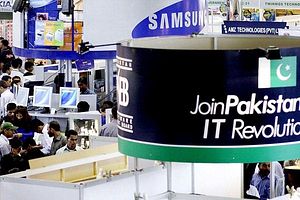The Information Technology sector of Pakistan, supported by some smart high-tech professionals and entrepreneurs, has created a global stir. Within the public sector, the government of Punjab has taken a lead role in this regard. The provincial government’s recent quick shift to use information and communication technology (ICT) to improve governance and public services, has attracted a lot of attention lately.
One of the noted aspects of these interventions is that things have shifted into overdrive as far as the accessibility of public service and delivery time is concerned. At policy level, the objective behind this paradigm shift appears to be aimed at cutting down protracted and frustrating bureaucratic structures whose malfunction have largely been blamed for the “performance handicap” in the public sector.
Dr. Umar Saif, the chairman of the Punjab Information Technology Board (PITB), over the last couple of years, has made great strides toward the realization of this goal. The result has been an accelerating shift toward an unparalleled use of technology to improve good governance. In this regard, PITB has introduced a number of flagship projects in the areas of counterterrorism, crime, law, education, agriculture, and others. Moreover, a number of citizen facilitation centers have been setup across Punjab to boost the efficiency and effectiveness of services given to public.
In the education sector, PITB’s “Smart Monitoring” initiative has proved highly effective in improving the performance of public schools by collecting real-time data on different key performance indicators. Under this initiative, each of the 36 districts in Punjab are monitored on an individual basis by the government’s monitoring officers, who are tasked with visiting and reporting on 52,695 public schools registered across the province every month. The activity of monitoring officers is geotagged to ensure their timely visits. To make the process more open and transparent and increase citizen’s participation, all collected data in this regard and its real-time performance and monitoring have been made available online for public access.
To combat terrorism, crime, and enhance the performance of police, different tech-based initiatives are being put in place. The automation of Punjab’s Counter Terrorism Department (CTD) as well as digitalization of the criminal database and suspect profiling have helped in the apprehension of number of suspects who have previously evaded justice. A few months ago, one suspect with multiple identities was recognized as one person by the Punjab police due to the effective use of a digital criminal fingerprint database, which is being implemented across the province.
Furthermore, the PITB-developed Crime Mapping (CM) software has facilitated police in identifying some of the long established and emerging crime pockets in the province. The software has also proven valuable in helping the provincial law enforcement agencies in conducting electronic crime investigations, devising better strategies to preempt, discover, and control criminal acts. Moreover, to tighten a noose around hardened criminals and terrorists, the police in Lahore has made it essential for all hotels to use the “Hotel Eye” software in order to monitor the record and information of all visitors and guests staying there. In the last two months, the city police have been able to arrest 43 criminals from different hotels in Lahore by using the software.
Above all, besides improving transparency, CM software will also help in reducing the much reported and rampant corruption in police department. In this regard, reforms related to “Paperless Policing” such as real-time monitoring of police stations, online FIR submissions and screening of the investigation progress, and biometric attendance of police personnel is being employed. Currently, the initiative is being used in Lahore but the government plans to expand it to the entire province.
The agriculture sector is another area where the provincial government is making much needed technology based interventions. Among other efforts to improve the sector, Punjab government is planning to provide smart phones to about 600,000 farmers in the province to better the output of crops.
The explosive boom of Pakistan’s IT industry has begun to penetrate into almost every sphere of public sector by offering new tools and systems to improve their performance. The trend is being noticed at all levels: Plans are underway to conduct the next national census with the effective deployment of technological methods; Pakistan Railway is preparing to computerize its ticketing system; and Pakistan customs will soon be using smart phones for snap checking vehicles on the roads, which could help in the identification of illicit smuggled goods and traders.
“Every level of government can be managed and is required to be managed using IT in this new digital world. Introduction of robust mobile technologies has made it absolutely essential for governments worldwide to introduce IT-based customer services in each department,” maintains Bilal Bajwa, a consultant and analyst at the Rockwell Automation.
Burhan Rasool, the head of software department wing at the PITB, says that “transparency and trust in the public sector can be improved by making citizens a part of the policy making process.” Rasool further asserts that “part of this can be achieved by making public the government’s working and data as a way to keep citizens informed about what is happening inside the power corridors.”
In the long run, the improved transparency, government accountability before its citizens, and effectiveness of service delivery due to these interventions will certainly increase public trust in the public sector, which is essential in strengthening the democratic process of any country.
































